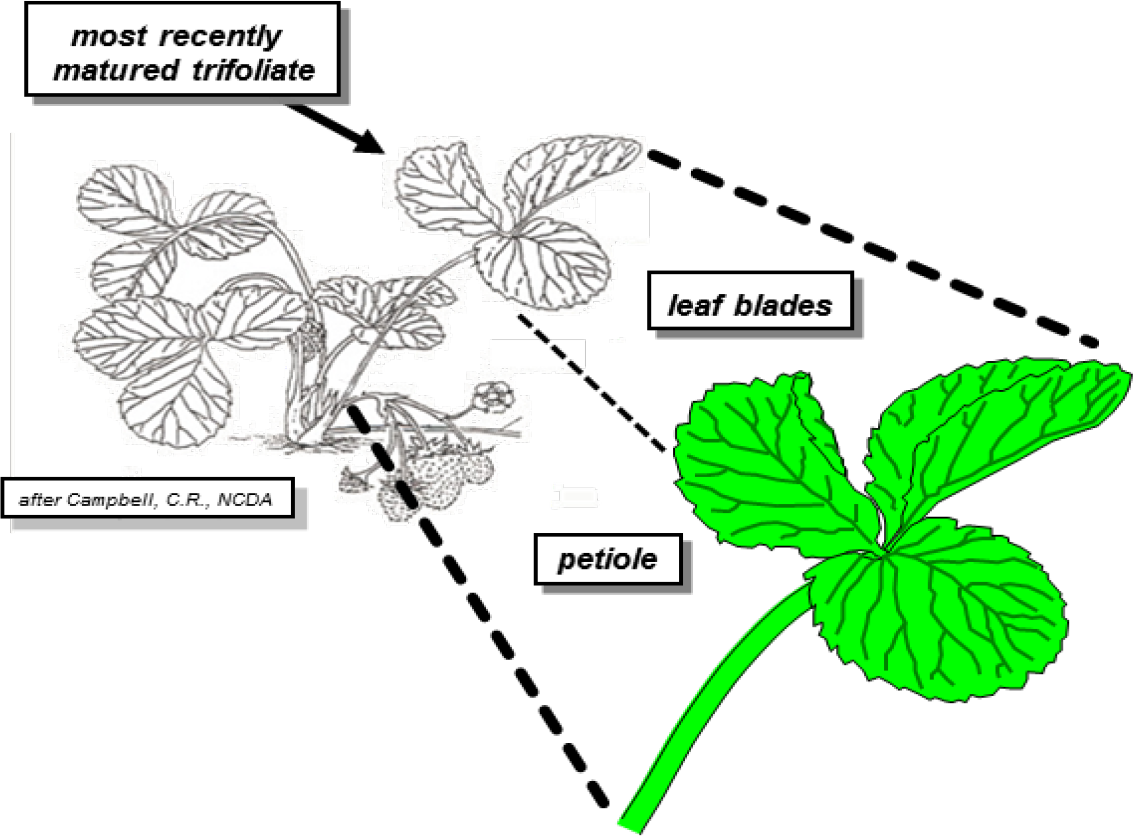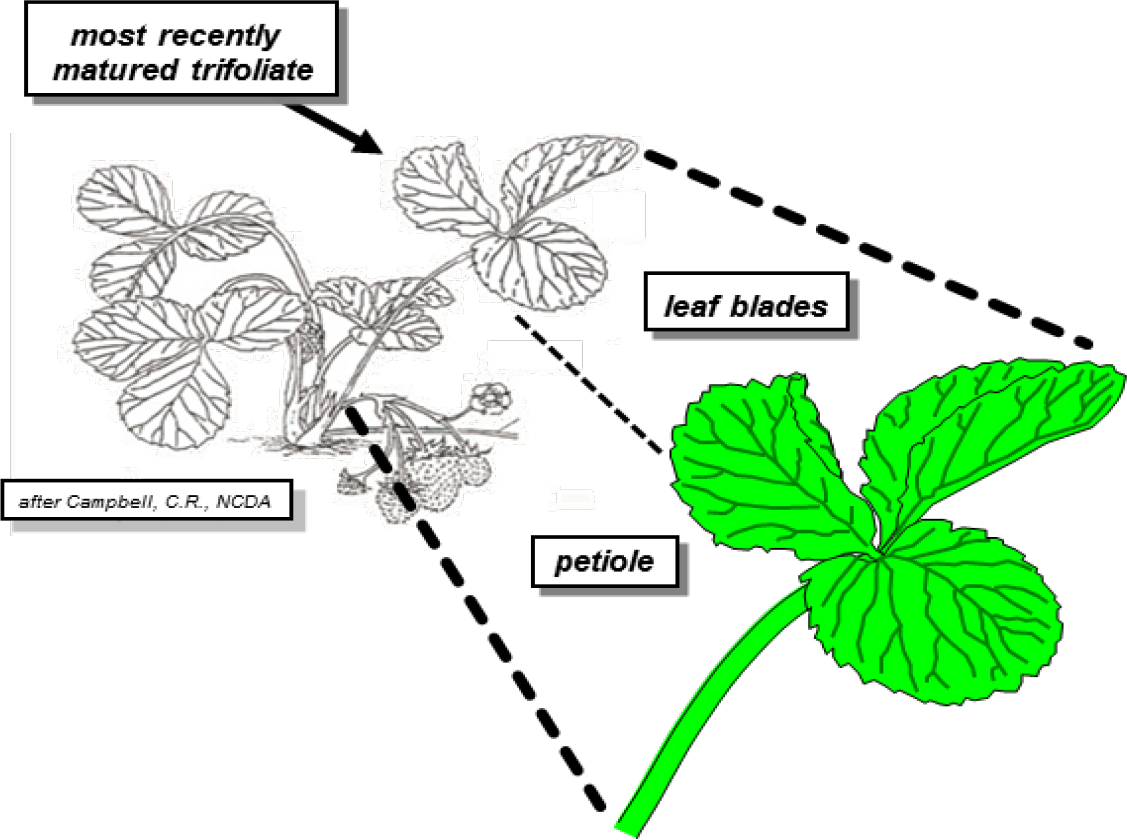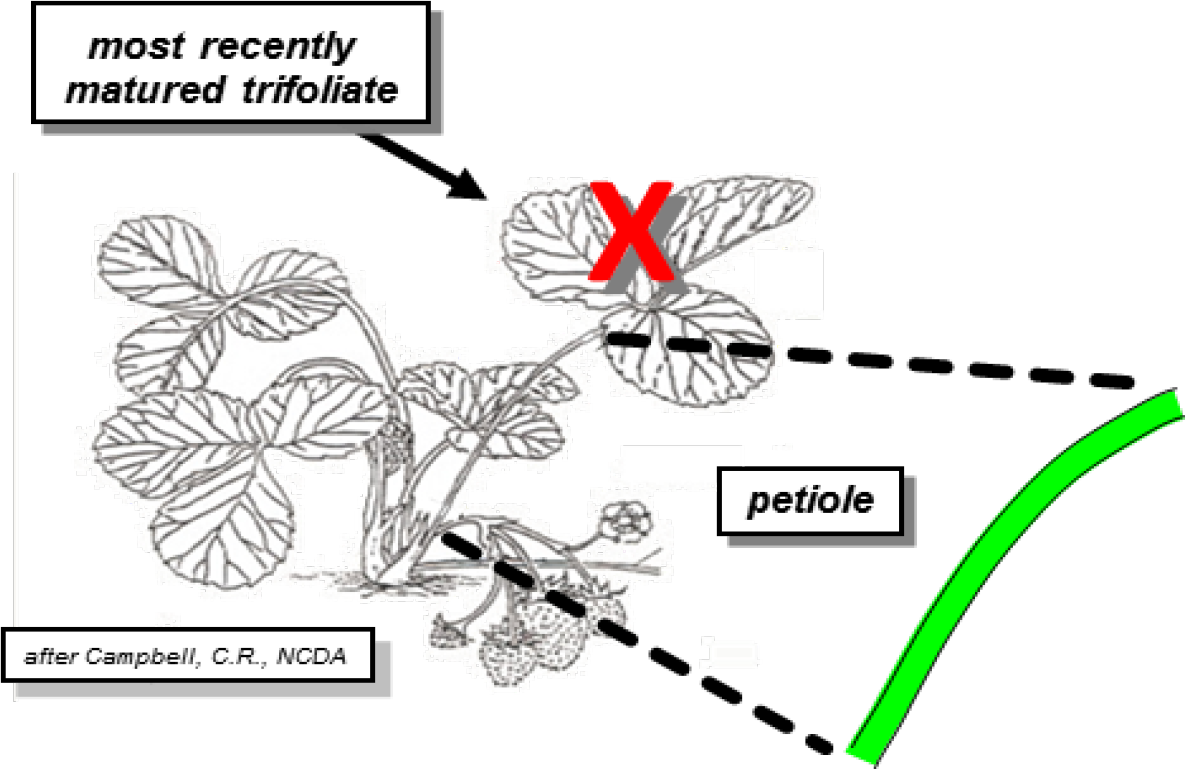⇦ Back to Soil Fertility and Plant Nutrition Home
¶ Strawberry (Fragaria × ananassa)
| Table No: | Growth stage: | Plant part: |
| Table A | Early harvest | Mature leaves and petiole |
| Table B | Mid-season | Mature leaves and petiole |
| Table C | Growing season | Petiole |
¶ A: Early harvest
Plant Part: Most recently mature leaves with petioles
Sampling Procedure: Select the most recently mature, trifoliate leaves usually located three to five leaves back from the growing point. These leaves are full-sized and consist of one petiole or leaf stalk with three green leaflets. Include leaves and petioles from 20 to 25 plants within a uniform area. Using knife or scissors may spread disease. Submit at least a pint of loosely packed tissue (a ball about 4 to 5 inches in diameter). Place samples in paper bag - not plastic - for shipment.
| Analysis | Tissue Concentration Guidelines | ||||||||
| Low/Marginal Range | Sufficiency Range | Excessive, toxic? | |||||||
| Nitrogen, % N | 1.5 | - | 1.8 | 2.2 | - | 3.5 | |||
| Phosphorus, %P | 0.18 | - | 0.2 | 0.2 | - | 0.45 | |||
| Potassium, % K | 1.5 | - | 1.8 | 1.8 | - | 2.5 | |||
| Calcium, % Ca | 0.4 | - | 0.6 | 0.7 | - | 1.7 | |||
| Magnesium, % Mg | 0.2 | - | 0.25 | 0.25 | - | 0.5 | |||
| Sulfur, % S | 0.15 | - | 0.25 | 0.25 | - | 0.8 | |||
| Zinc, ppm Zn | 15 | - | 25 | 25 | - | 60 | |||
| Iron, ppm Fe | 25 | - | 50 | 50 | - | 250 | 1000 | ||
| Manganese, ppm Mn | 25 | - | 30 | 30 | - | 250 | 800 | ||
| Copper ppm Cu | 5 | - | 7 | 7 | - | 20 | |||
| Boron, ppm B | 20 | - | 25 | 25 | - | 50 | |||
| Nitrogen-to-sulfur ratio (N:S) | 0.01 | - | 0.3 | ||||||
| Sodium, % Na | 0.60 | - | 1.00 | ||||||
| Chloride, % Cl | |||||||||
¶ Figure A.

¶ B: Mid-season
Plant Part: Most recently mature leaves with petioles
Sampling Procedure: Select the most recently mature, trifoliate leaves usually located three to five leaves back from the growing point. These leaves are full-sized and consist of one petiole or leaf stalk with three green leaflets. Include leaves and petioles from 20 to 25 plants within a uniform area. Using knife or scissors may spread disease. Submit at least a pint of loosely packed tissue (a ball about 4 to 5 inches in diameter). Place samples in paper bag - not plastic - for shipment.
| Analysis | Tissue Concentration Guidelines | ||||||||
| Low/Marginal Range | Sufficiency Range | Excessive, toxic? | |||||||
| Nitrogen, % N | 1.4 | - | 1.7 | 2 | - | 3 | |||
| Phosphorus, %P | 0.18 | - | 0.2 | 0.2 | - | 0.45 | |||
| Potassium, % K | 1.2 | - | 1.5 | 1.5 | - | 2.2 | |||
| Calcium, % Ca | 0.4 | - | 0.6 | 0.7 | - | 1.7 | |||
| Magnesium, % Mg | 0.15 | - | 0.2 | 0.2 | - | 0.4 | |||
| Sulfur, % S | 0.15 | - | 0.25 | 0.25 | - | 0.8 | |||
| Zinc, ppm Zn | 15 | - | 25 | 25 | - | 60 | |||
| Iron, ppm Fe | 25 | - | 50 | 50 | - | 250 | 1000 | ||
| Manganese, ppm Mn | 20 | - | 25 | 25 | - | 200 | 800 | ||
| Copper ppm Cu | 5 | - | 7 | 7 | - | 20 | |||
| Boron, ppm B | 20 | - | 25 | 25 | - | 50 | |||
| Nitrogen-to-sulfur ratio (N:S) | 0.01 | - | 0.3 | 0.60 | - | 1.00 | |||
| Sodium, % Na | |||||||||
| Chloride, % Cl | |||||||||
¶ Figure B.

¶ C: Growing season
Plant Part: Petiole
Sampling Procedure: Select the most recently mature, trifoliate leaves usually located three to five leaves back from the growing point. These leaves are full-sized and consist of one petiole or leaf stalk with three green leaflets. Include petioles from 30 to 50 plants within a uniform area. Collect a separate sample of leaves plus petioles for complete nutrient analysis. Using knife or scissors may spread disease. Place samples in paper bag - not plastic - for shipment.
| Sampling time | Tissue concentration guidelines | |||
| Nitrate, ppm NO3-N | ||||
| Sufficiency | Excessive | |||
| Dormant | < 500 | |||
| Bloom + 1 week | 600 | - | 1,500 | > 5,000 |
| Bloom + 2 weeks | 4,000 | - | 6,000 | > 10,000 |
| Bloom + 3 weeks | 4,000 | - | 6,000 | > 10,000 |
| Bloom + 4 weeks | 3,500 | - | 6,000 | > 10,000 |
| Bloom + 5 weeks | 3,000 | - | 5,000 | > 9,000 |
| Bloom + 6 weeks | 3,000 | - | 5,000 | > 9,000 |
| Bloom + 7 weeks | 3,000 | - | 5,000 | > 9,000 |
| Bloom + 8 weeks | 3,000 | - | 5,000 | > 9,000 |
| Bloom + 9 weeks | 2,000 | - | 4,000 | > 7,000 |
| Bloom + 11 weeks | 1,500 | - | 3,000 | > 5,000 |
| Bloom + 12 weeks | 1,000 | - | 2,000 | > 3,000 |
| Post-harvest | 400 | - | 600 | |
¶ Figure C.

Note: Interpretations are based the relationship between nutrient levels in a particular part of a "standard" tissue in a specific time in the growing season. These plant tissue ranges and interpretations are not considered valid with plant parts or growth stages other than those specified. These interpretations are developed from data collected across a wide range of crop, soil, and climate conditions.
Results from a single sample may be affected by time of day, climatic conditions, plant stress, age, or disease, that are not directly related to fertility status. Nutrient concentrations are not uniform throughout the plant and may change as the tissue matures.Tissue analysis trends should be evaluated by variety, growing season, and yield/quality goals. Collecting plant samples from the same location as soil samples allows comparison of soil nutrient availability with plant nutrient status.Low nutrient levels may be due to deficiency or to dilution by intensive growth. High or excessive nutrient levels may be a sign of restricted growth allowing nutrients to accumulate in the plant tissue. Nutrient imbalance may be secondary to the primary problem.